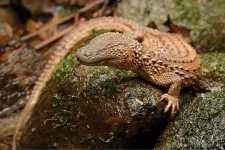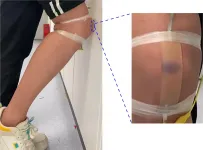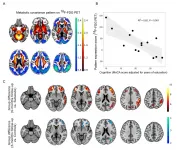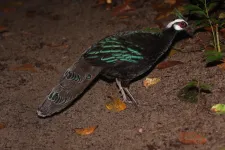(Press-News.org) Should zoos display legally protected species that have been smuggled out of their range countries? A new study suggests that a pause and rethink may be needed, as it reports that accredited zoos have acquired a rare and legally protected reptile, the earless monitor lizard endemic to Borneo, without any evidence that the animals were legally exported.
The earless monitor lizard occurs only on the island of Borneo and has been described as a "miniature Godzilla" and "the Holy Grail of Herpetology." Discovered by western scientists almost 150 years ago, for most of this period the species was known largely from pickled specimens in natural history collections, and wasn't recorded from the wild for decades. In the 1970s, the three countries that make up Borneo - Indonesia, Malaysia and Brunei - added it to their protected species lists. This means that the species can neither be legally traded within these countries, nor legally exported out of them.
Despite legal protection and lack of export permissions, reptile enthusiasts and unscrupulous traders have long been smuggling small numbers of earless monitor lizards out of Indonesia and Malaysia, eventually bringing them to Europe. This greatly accelerated in 2012, when the species' rediscovery was announced in a scientific journal. In 2016, all 183 countries that are signatory to the Convention on international trade in endangered species agreed to regulate global trade in earless monitor lizards in order to limit the negative effects of smuggling on wild populations. Agreed export numbers were set at zero.
Enforcing the laws has proven to be challenging, however, and to date only two smuggling attempts have been thwarted. In both cases, German smugglers were apprehended at Indonesian airports while attempting to move respectively eight and seventeen earless monitor lizards out of the country.
The first zoo that proudly announced it had obtained earless monitor lizards was Japan's iZoo in 2013. This zoo is not accredited, and the ways in which the animals were obtained remain questionable. In Europe, the first zoos to openly display earless monitor lizards were located in Hungary, Austria and the Czech Republic. The animals were obtained from what zoos referred to as "private individuals" or "dedicated hobby breeders", and, in one instance, from iZoo. Just like in Japan, how these animals ended up in Europe is questionable, but perhaps not illegal - and it is evident that no export permits were ever issued.
In recent years, more and more zoos in Europe, and since the beginning of this year also in the United States, have started displaying earless monitor lizards. Some cases were part of zoo exchanges, others were obtained from private individuals, and a handful were placed in zoos by authorities after they were seized, but it is clear that many were at one point illegally exported out of Indonesia, Malaysia or Brunei, or were illegally imported into non-range countries.
The acquisition of these protected lizards by zoos is neither in line with the intentions of national laws of their countries of origin, nor with international wildlife trade regulations. Moreover, it is diametrically opposed to the commitments the international zoo community has made to address illegal wildlife trade.
"To me, the current situation concerning the purchasing and proudly displaying of earless monitor lizards by accredited zoos can be compared with a road safety organisation posting online videos of its CEO doing wheelies on a motorbike and then adding that it was done on a private road where neither wearing a helmet nor having a driver's licence is required," said Vincent Nijman of the Oxford Wildlife Trade Research Group, author of the study that was published in the open-access journal Nature Conservation. "Both may be legal in a technical sense, but the optics are not good."
"Modern, scientifically managed zoos are increasingly organising themselves with set ethical values and binding standards which go beyond national legislation on conservation and sustainability, but, unfortunately, this still only counts for a small proportion of zoos worldwide," said Dr Chris R. Shepherd, Executive Director of Monitor Research Conservation Society. "Zoos that continue to obtain animals that have been illegally acquired, directly or indirectly, are often fuelling the illegal wildlife trade, supporting organised crime networks and possibly contributing to the decline in some species."
Seven years ago, the price for a single earless monitor lizard was in the order of EUR 8,000 to 10,000 , so any zoo or hobbyist wanting to have one or more pairs had to make a serious financial commitment. These high prices put a restriction on the number of people that wanted to acquire them and could afford them. It probably also gave potential buyers a tacit reminder that the trade was illicit. In recent years, however, prices have come down, to less than EUR 1,000. Now that earless monitor lizards are more affordable, and with accredited zoos giving a sense of legitimacy, Nijman is concerned that it might become more and more acceptable to keep these rare animals as pets.
"When I grew up in the 1970s, it was still perfectly acceptable for what we now see as accredited zoos to regularly buy rare and globally threatened birds, mammals and reptiles from commercial animal traders. Few questions were asked about the legitimacy of this animal trade. This has dramatically changed for the better, and now many of the animals we see in zoos today have been bred in captivity, either in the zoo itself, or in partner zoos", Nijman said. He added that in many ways zoos are a force for good in the global challenge to preserve species and conserve habitats. "It is imperative that these efforts are genuinely adopted by all in the zoo community, and, when there is doubt about the legitimacy of animals in trade, that a cautionary approach is adopted."
INFORMATION:
Original source:
Nijman V (2021) Zoos consenting to the illegal wildlife trade - the earless monitor lizard as a case study. Nature Conservation 44: 69-79. https://doi.org/10.3897/natureconservation.44.65124
American Indian and Alaska Native Enrollment in Clinical Studies in the National Institutes of Health's Intramural Research Program
Dejonna Vigil, Ninet Sinaji, and Barbara Karp
This is the first study to provide data about the inclusion of American Indians and Alaska Natives in the National Institutes of Health's Intramural Research Program (NIH-IRP), which provides eligible individuals with access to innovative research treatments that may not otherwise be available. The program's mission is to include all Americans. This study analyzed data from more than 1,800 NIH-IRP protocols active in 2014 and 2017. While the number of American ...
When someone bumps their elbow against a wall, they not only feel pain but also might experience bruising. Robots and prosthetic limbs don't have these warning signs, which could lead to further injury. Now, researchers reporting in ACS Applied Materials & Interfaces have developed an artificial skin that senses force through ionic signals and also changes color from yellow to a bruise-like purple, providing a visual cue that damage has occurred.
Scientists have developed many different types of electronic skins, or e-skins, that can sense stimuli through electron transmission. However, these electrical conductors are not always biocompatible, which could limit their use in some types of prosthetics. In contrast, ionic skins, or I-skins, ...
Researchers at Karolinska Institutet in Sweden found industrial chemicals in the organs of fetuses conceived decades after many countries had banned the substances. In a study published in the journal Chemosphere, the researchers urge decision makers to consider the combined impact of the mix of chemicals that accumulate in people and nature.
"These are important findings that call for regulators to consider the collective impact of exposure to multiple chemicals rather than evaluating just one chemical at a time," says first author Richelle Duque Björvang, PhD student at the Department of Clinical ...
As consumers and corporations alike become more environmentally conscious, the chemical industry is working to find solutions to the plastic waste crisis. One idea is to use biodegradable polymers known as polyhydroxyalkanoates (PHA) as replacements for traditional plastic packaging and other materials. A feature article in Chemical & Engineering News, the weekly newsmagazine of the American Chemical Society, explores the possibilities and pitfalls of PHA.
PHA is not a new human invention; this class of polymers can be found in nature and is used to store cellular energy, writes Senior Editor Alex Tullo. Commercially, it is manufactured through the industrial fermentation of sugars or lipids. As cities ...
Researchers from the Singapore University of Technology and Design (SUTD) have demonstrated a technology that rapidly detects pollutants in water by measuring their impacts on swimming microorganisms.
Their proof-of-concept, published in Scientific Reports, does not require any chemicals, reagents or laboratory equipment. Instead, it leverages the regular camera of a smartphone as well as microorganisms called Paramecia that are ubiquitous in water bodies--making it especially suitable for assessing water drinkability in underdeveloped regions.
Typically, levels of environmental pollutants are measured by assessing their impact on a given population. Though such impacts may be visible after several days for microorganisms, it takes several years for the true scale to be ...
People with a rare autoimmune disease, who likely experience more serious isolation during a global pandemic, saw their anxiety and depression improve after receiving online mental health intervention through an international study involving investigators from Michigan Medicine.
The paper, END ...
Reston, VA--The effects of COVID-19 on the brain can be accurately measured with positron emission tomography (PET), according to research presented at the Society of Nuclear Medicine and Molecular Imaging (SNMMI) 2021 Annual Meeting. In the study, newly diagnosed COVID-19 patients, who required inpatient treatment and underwent PET brain scans, were found to have deficits in neuronal function and accompanying cognitive impairment, and in some, this impairment continued six months after their diagnosis. The detailed depiction of areas of cognitive impairment, neurological symptoms and comparison of impairment over a six-month time frame has been selected as SNMMI's 2021 Image of the Year.
Each year, SNMMI chooses an image that best exemplifies the most promising ...
LMU researchers have identified the 14-3-3sigma gene as an important suppressor of carcinogenesis in the gastrointestinal tract.
Intestinal cancers, also known as colorectal cancer, are among the most prevalent forms of malignancy worldwide. If detected early enough, tumors can be surgically excised. However, as cancer growth progresses, cells may escape from the primary tumor, which can then establish metastatic tumors in other organs. Once such satellite tumors have formed, survival rates fall significantly. Formation of the initial tumor can be triggered by mutations in any of a number of genes. Together with postdocs ...
CHAMPAIGN, Ill. -- Health care workers often don't adopt new guidelines for best practices in medical care until well after those guidelines are established. A team of researchers led by Eunice E. Santos, the dean of the School of Information Sciences at the University of Illinois Urbana-Champaign, has developed a new computational modeling and simulation framework to analyze decision-making and identify effective dissemination strategies for medical guidelines.
The research team examined guidelines for Type 2 diabetes that were established in 2012 and were still not adopted years later. The researchers found that health ...
The lush forests and more than 7,000 islands of the Philippines hold a rich diversity of life, with 258 bird species who live nowhere but the Philippine archipelago. A new study from University of Utah researchers suggests that, due to deforestation and habitat degradation, more bird species may be endangered that previously thought - including species that may not have been discovered yet. The study is published in Frontiers in Ecology and Evolution.
"Our study provides a roadmap for not only which species may warrant heightened conservation attention," says Kyle Kittelberger, a doctoral student in the University of Utah School of Biological Sciences, "but which traits ...




